BEHIND the CURTAIN to ALEXANDER MCQUEEN’S CREATIVE UNIVERSE
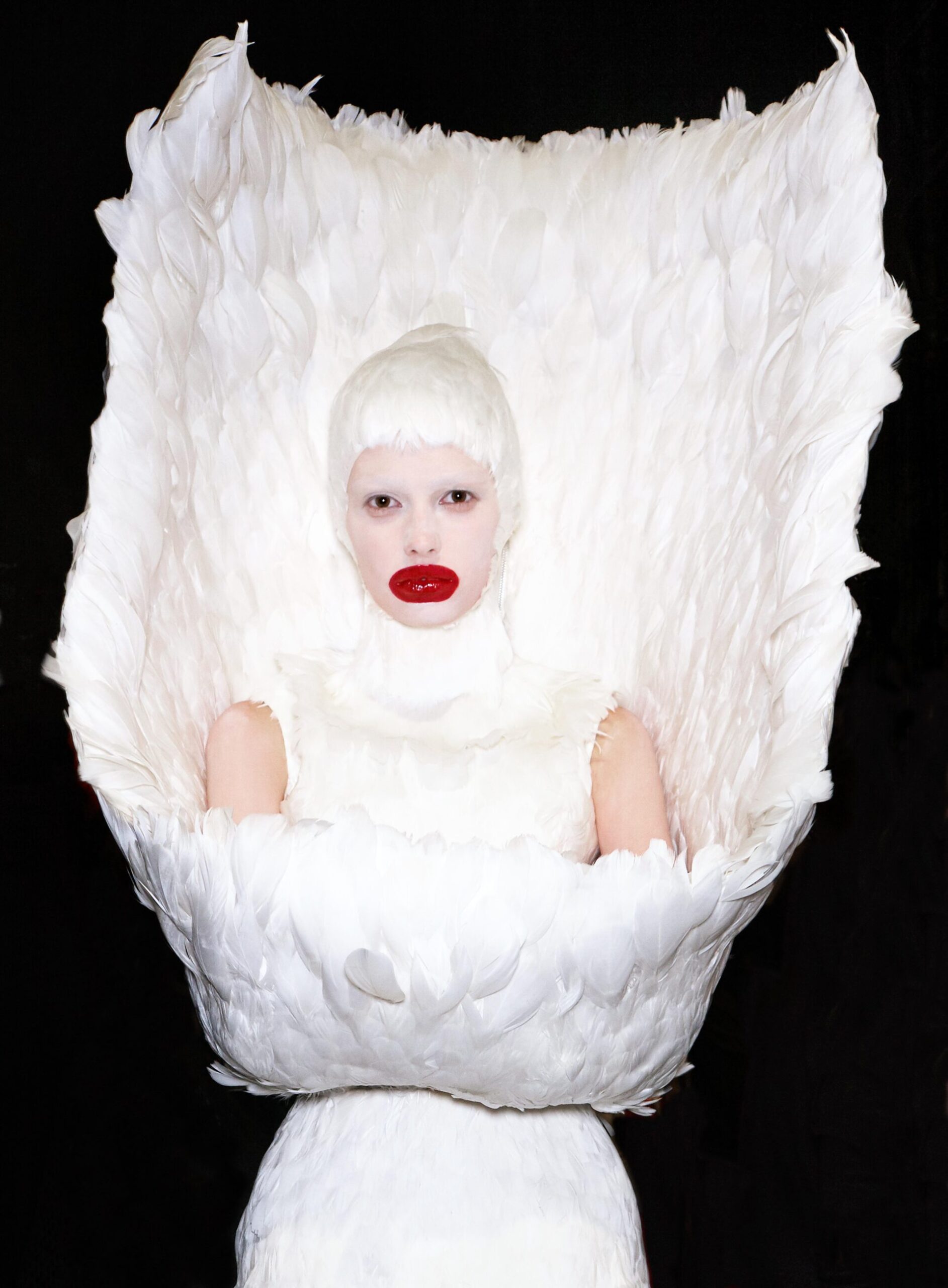
In the space of 18 years, Lee Alexander McQueen created and presented clothes that blurred the line between fashion, art, design and storytelling, relentlessly challenging the construct and confines of the fashion industry along the way. A master of efficiency, McQueen harnessed the material and people in his orbit to build new worlds and powerful visual narratives. No matter how closely we followed his trajectory, memorable moments of McQueen’s life and highlights from his 36 collections were seared into our minds as we watched the rule book being rewritten through fashion that felt dangerous and brilliant. Though only a couple of hundred people were physically present at most of his shows, we share a collective understanding of the energy and anticipation that led up to each McQueen runway; a collective understanding of the atmosphere and emotion he created inside. But while photographs, videos and endless recounts paint a compelling picture of what it might have been like to be there, to see the clothes in front of you is quite another thing.
The recent Alexander McQueen: Mind, Mythos, Muse exhibition at the NGV—which opened in December 2022, 12 years after McQueen’s passing—featured key pieces from many of his collections. Building on an exhibition held at the Los Angeles County Museum of Art a few months prior, the exhibition paired rarely seen McQueen designs from both galleries’ archives with artworks and artefacts that influenced some of his most iconic ideas. As Katie Somerville, Senior Curator of Fashion and Textiles at the NGV explained, McQueen was influenced by “a myriad of sources throughout art history, ancient history, popular culture, music and cinema across the board.” This show revealed some of these specific correlations.
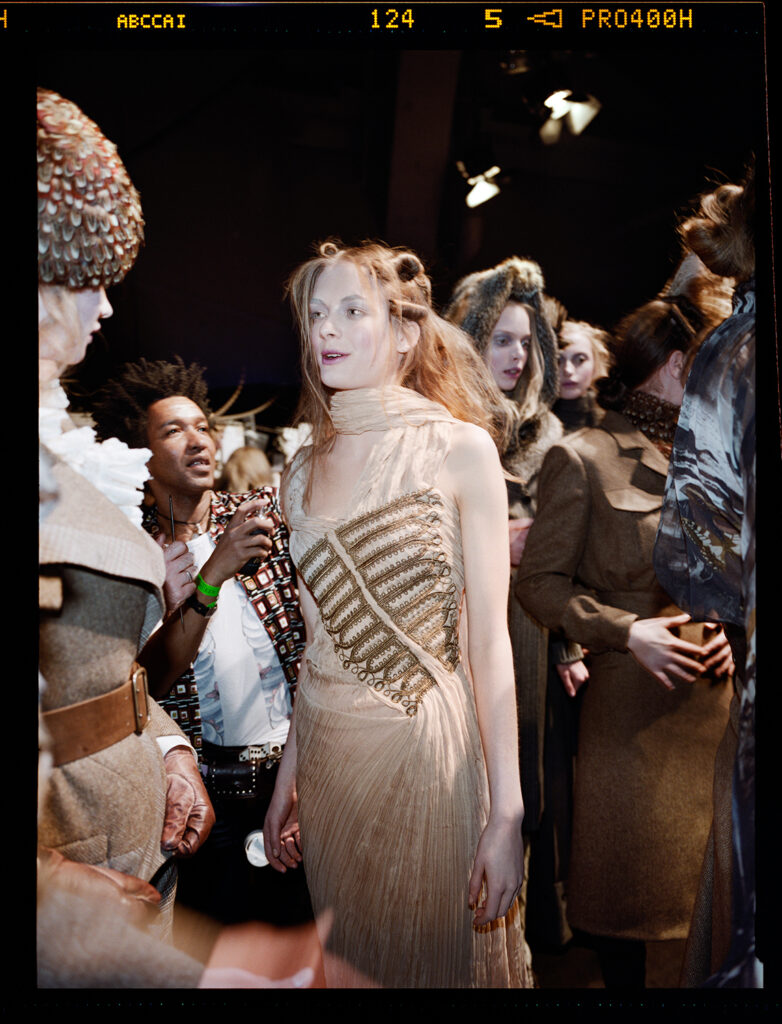
In the exhibition, we saw how McQueen fused “religious symbols and silhouettes, historical secular dress and contemporary fashion, costume and artistic traditions drawn from various cultures” to complete his multifaceted vision. Alongside garments from his 1995 Highland Rape collection and the later 2006 Widows of Culloden collection, for example, we saw how the designs incorporate the traditional MacQueen tartan of his ancestors, as well as elements of Scotland’s natural landscape. Rooted in his own personal history and romanticised historical references, in hindsight, it becomes very clear how his work explored themes of tradition, power, persecution, violence and metamorphosis.
McQueen’s love of film and contemporary art was also explored. The direct influence of the film They Shoot Horses, Don’t They? on his 2004 Deliverance collection is elaborated on as a bleak metaphor for working in fashion. Similarly, his 1995 runway show titled The Birds—featuring dresses crafted from thousands of feathers—drew inspiration from Alfred Hitchcock’s film of the same name. In another section, an MC Escher work came to life beside the chequered prints of his 2009 show Horn of Plenty. Further in, alongside pieces from the 2010 Angels and Demons collection, we saw the original painting from 1550 that was printed on his elongated bodices and the iconography from the Byzantine Empire that inspired his silhouettes as he recast contemporary women as empowered warriors. Finally, digitally printed dresses from his second to last collection Plato’s Atlantis in 2010 were featured next to glazed earthenware from Portugal, revealing watery patterns and textures drawn from animals from the land, sky and sea.
While seeing McQueen’s designs paired with the works that inspired them was a welcome deep dive into the origins of his ideas, it was also the backstage photography of Robert Fairer that helped bring his work to life. Fairer’s hyperreal snapshots of models getting ready before a show or preparing to navigate the catwalk are a literal peek behind the curtain of these groundbreaking moments in fashion history. Working in the years before social media took over—for context, Instagram was launched six months after McQueen died—these images are like vivid viewfinders into his collaborative universe.
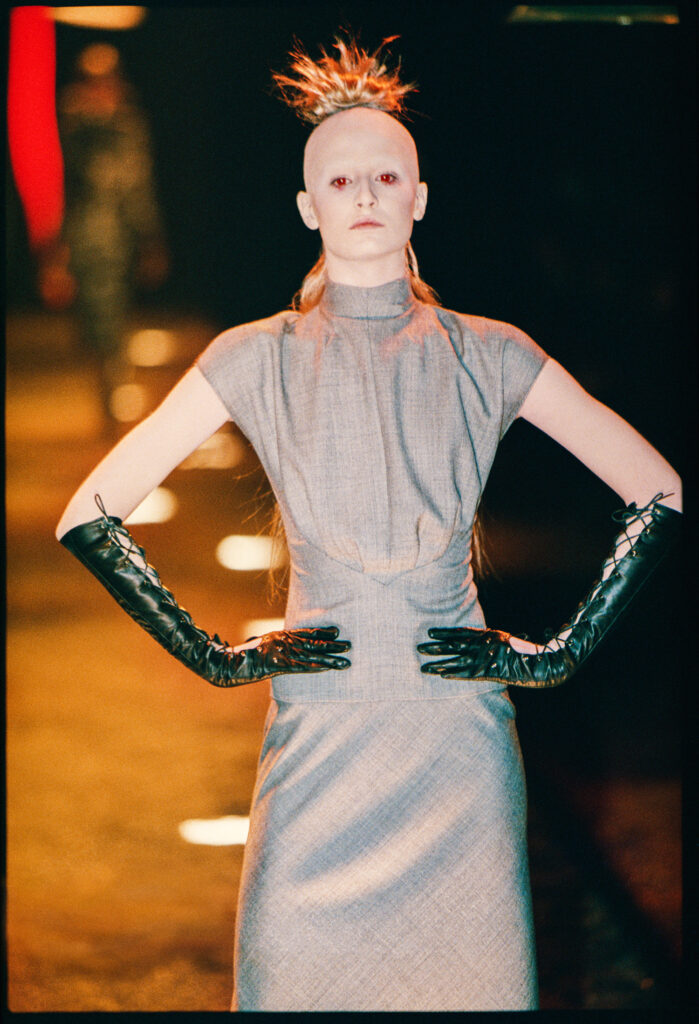
ROBERT FAIRER, Dress and gloves from the Joan FW1998 collection, 1998.
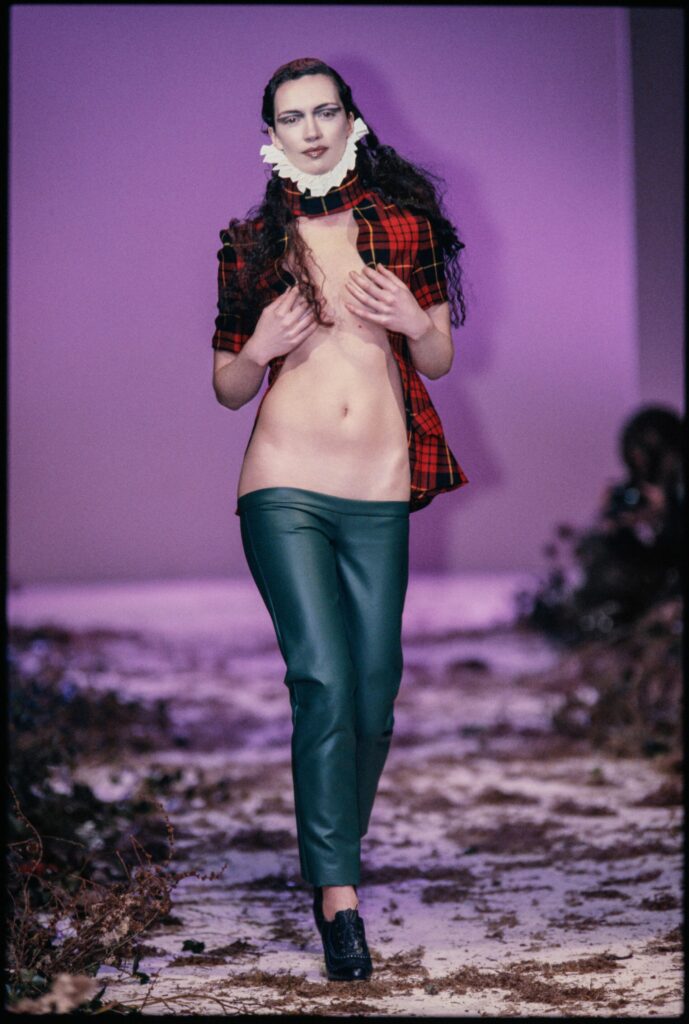
ROBERT FAIRER, Shirt and trousers from the Highland Rape AW1995–96 collection, 1995.
In Melbourne, for the exhibition opening, Fairer explained that he’s shot behind-the-scenes images at thousands of shows. More so, he was the only photographer granted backstage access at many of McQueen’s runways. In contrast to the fast-paced turnaround and digital-media led ubiquity of fashion week imagery now, Fairer’s images are considered artworks themselves. Thanks to his tenacity and instinct for capturing fleeting moments, we have a record of what it might have been like backstage with the designer himself. As Fairer remarked, “After some time shooting, I realised I was witnessing moments that literally no one else saw, not even necessarily the people working directly with McQueen. I captured this fleeting magic that was gone in an instant. Backstage there’d be people everywhere then suddenly the waters would part and I’d have to capture what I saw before it faded away like an etch-a-sketch. Catherine Brickhill, an early designer and great friend of McQueen’s, told me that even she had no recollection of any of this happening backstage and without these images, there would be no memory of this space.”
Backstage Fairer saw McQueen in his element—guiding his team to make his particular brand of magic. Fairer understood from the beginning, from the moment he shot Nihilism in 1994—McQueen’s first staged runway with models who appeared to have been victims of a car wreck—that he was witness to something special. He was there when the first pair of bumsters hit the catwalk, he was there to see the audience’s reaction as models staggered down the runway for Highland Rape, to see Kate Moss as a giant hologram for Widows and Shalom Harlow being spray-painted by choreographed robots for the finale of No.13, and he was there for the extravagance of Horn of Plenty and La Dame Bleue. Given his rare insight, Fairer loved being able to show McQueen in a different light to how he was regularly portrayed. In one classic photo, McQueen is immortalised, laughing with models backstage while wearing the giant purple bunny suit he closed the show in. It’s an image that clearly captures the joy of the moment. As Fairer noted, “I do love that photograph, it’s one of my faves. A lot of formal portraiture I’ve seen of McQueen is dark and pensive, but I love this because it shows a different, lighter part of his personality.”
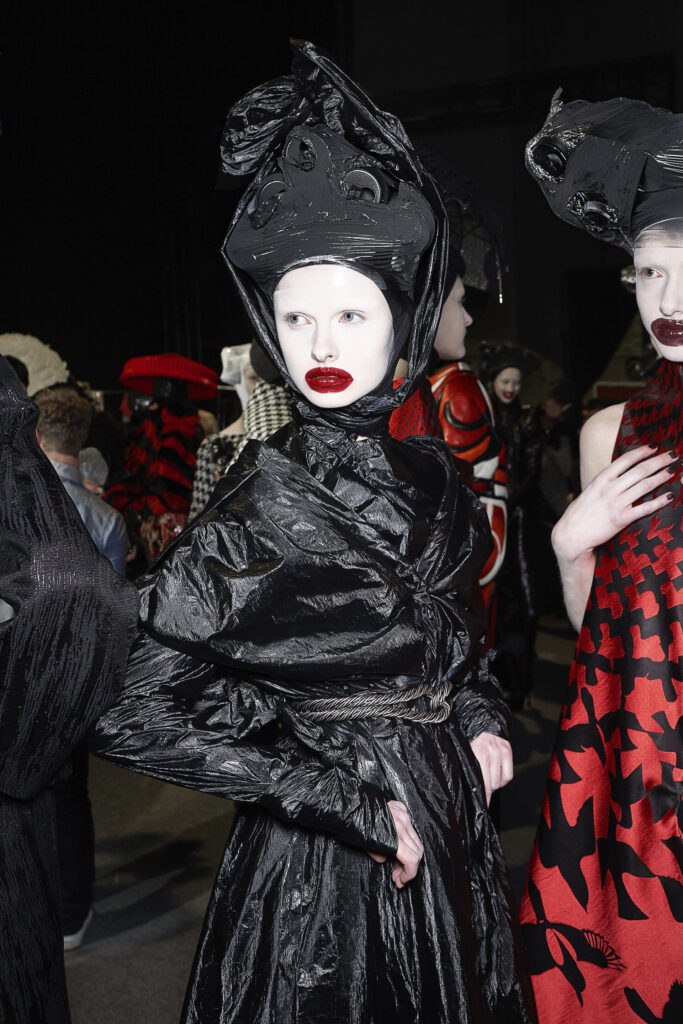
Another aspect of Fairer’s work that’s come into focus, in hindsight, is that the images he captured were as close to McQueen’s pure vision as we’ll ever see. He described: “What means so much to me is that my photos are the pure incarnation of the designer’s vision. In those photographs, everything that the models wear is chosen by McQueen: the shoes, the hair, the makeup, the entire look is his. As soon as the show is done and the clothes go out to the magazines, it’s sliced and diced, it has a fashion stylist’s perspective and it’s watered down. I’m glad I captured that purity of vision from a different perspective than in front of the runway.”
Fairer also recalls the palpable element of danger at McQueen’s shows, especially in the early years. How the execution of big ideas on a small budget meant that everything always felt like it was happening on a knife’s edge. Fairer can testify to how hands-on McQueen always was in order to bring his vision to life. He tells me a story from a show in London at the Gatliff bus depot. “There was no electricity in the depot so they’d just brought in huge electric cables and a generator. To warm the place up a bit they’d laid down some cheap carpet. I was backstage chatting to a friend when we started smelling smoke and saw that the carpet was about to catch fire. We started screaming, ‘Fire, fire!’ and next thing we knew, Alexander McQueen came running over with a bottle of diet coke, which I guess he planned to douse the fire with. My friend, who realised this wasn’t the solution for an electrical fire, tackled McQueen, stopping him just in time. Instead, someone grabbed a coat to smother the fire with. We all joked that luckily the jacket wasn’t Look 72 from the show. That was a close call. From a fashion show perspective, it could have been a real disaster. There was always a feeling that anything could happen at those shows, but that was also the attraction.”
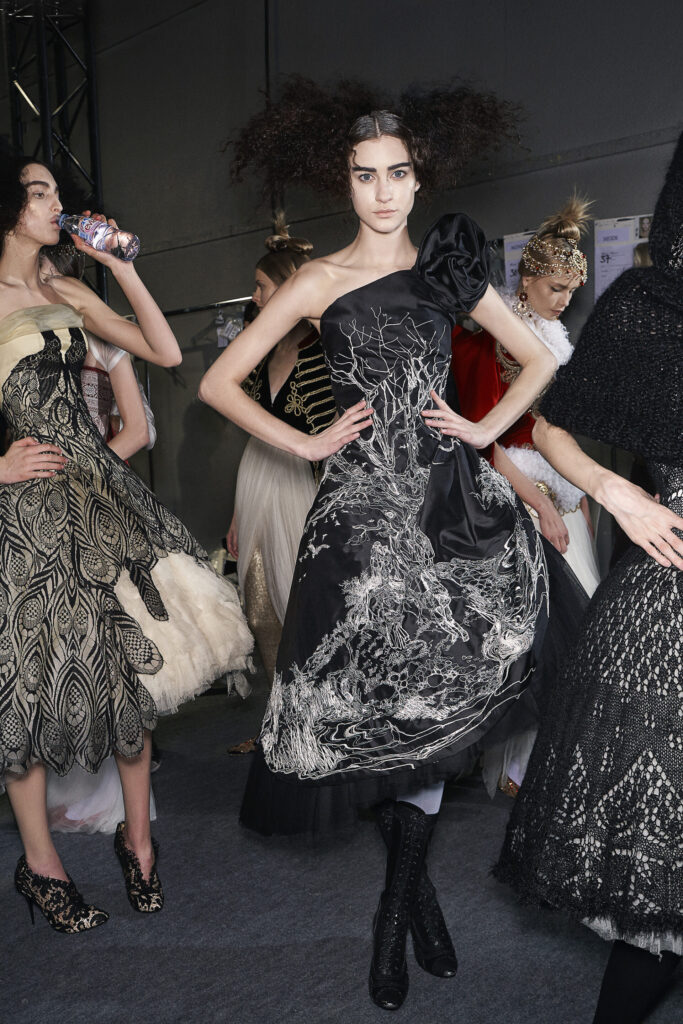

Interestingly, magazines weren’t initially fascinated by Fairer’s photos of the early McQueen shows. He explained that they might take one or two for shock value, typically for their makeup pages, but it wasn’t until McQueen’s appointment at Givenchy in 1996, when he became more well known, that his images were printed regularly. It was in 2001, when Fairer was hired by Anna Wintour at American Vogue, that his backstage photographs then found a regular home. He released his book Alexander McQueen: Unseen in 2016, which opened up his archive and shed light on some of his most intimate portraits.
“The joy of getting to do a book like Unseen, or an exhibition like this, is you get to look at one designer’s work, in this case, from A to Z,” Fairer said. “The NGV has done all the hard work—bringing together the garments from the four corners of the earth and tying the clothes to the art and artefacts. I’m glad my photography can help remind people of his brilliance and what he was saying about the fashion industry through his work. I remember watching Plato’s Atlantis, the first show to ever be streamed live around the world, and thinking how ahead of his time McQueen was in so many ways. Every single show had a message—it’s true that often his message was misinterpreted—but it always left you with something.” [EXEUNT]
Alexander McQueen: Mind, Mythos, Muse was recently on display at NGV International.
“The In Between”
By Kamilla Musland
Comfort Calling at Jil Sander
By Carwyn Mcintyre
Dream The World Awake
By Hugh Barton
The NGV Presents: 'Gabrielle Chanel. Fashion Manifesto'
By Costa Cavallo
How Melbourne’s favourite upcoming designers are redefining the codes of making and showing fashion in a post-pandemic industry
By Briony Wright
Rick Owens Brings Us Home For Fall/Winter 2024
By Katie Brown